Harry Knifton
Harry Knifton was born on 27th November 1894 at Red Hill Farm, Makeney, Derbyshire, the third child of James and Sarah Helen Knifton. He was baptised at Holy Trinity Church, Milford, on 6th January 1895.
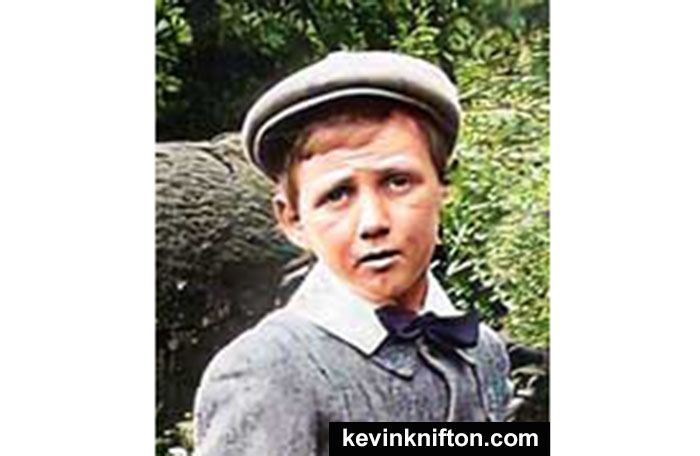 Harry Knifton, circa 1904
Harry Knifton, circa 1904
Harry grew up at Red Hill Farm and attended school in Duffield. He also attended Sunday School at Milford Church, and in 1905 he was presented with the novel John Halifax, Gentleman by Dinak Craik.
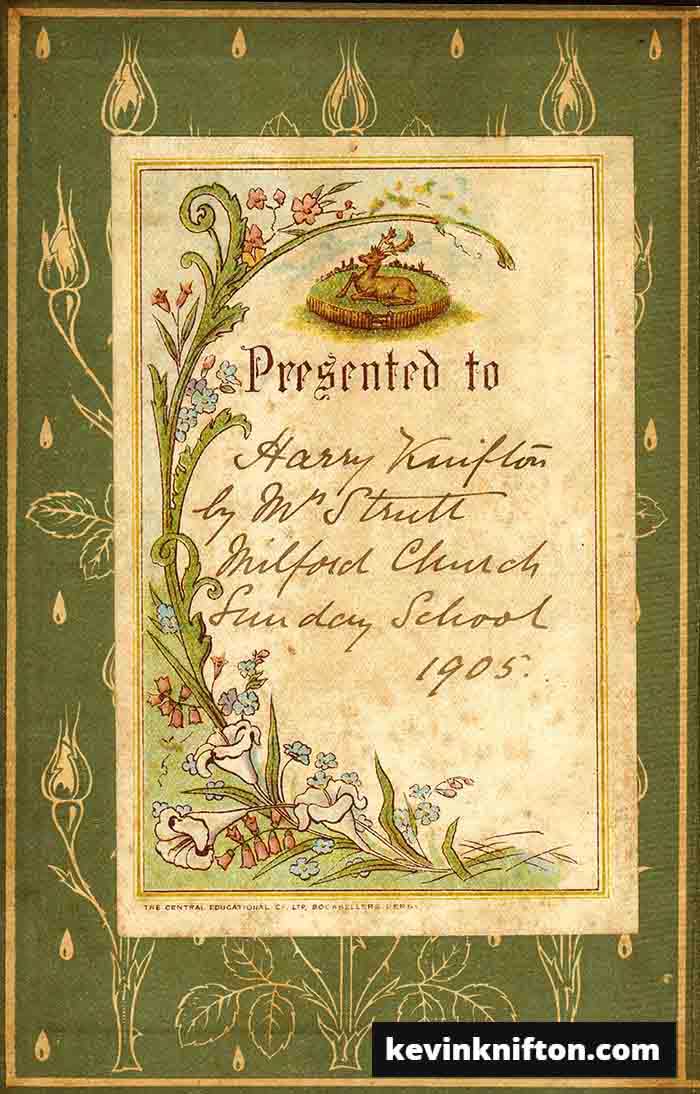 ‘Presented to Harry Knifton by Mr Strutt, Milford Church Sunday School 1905.’
‘Presented to Harry Knifton by Mr Strutt, Milford Church Sunday School 1905.’
Within three weeks of Harry’s 16th birthday, his father James William died on 19th December 1910 at the age of 49. His mother Sarah Helen continued to run the farm, supported by her three oldest children. Harry’s older sister Eva did the dairy work, while Harry and his older brother Frank did the farming. His younger brother John and sister Florrie were at school, and his younger brother James Russell was 3 years old.
Harry was confirmed on 29th February 1912 at Milford by the Bishop of Derby. His first communion, also at Milford, was on 17th March. He used to walk to church each Sunday morning with his mother.
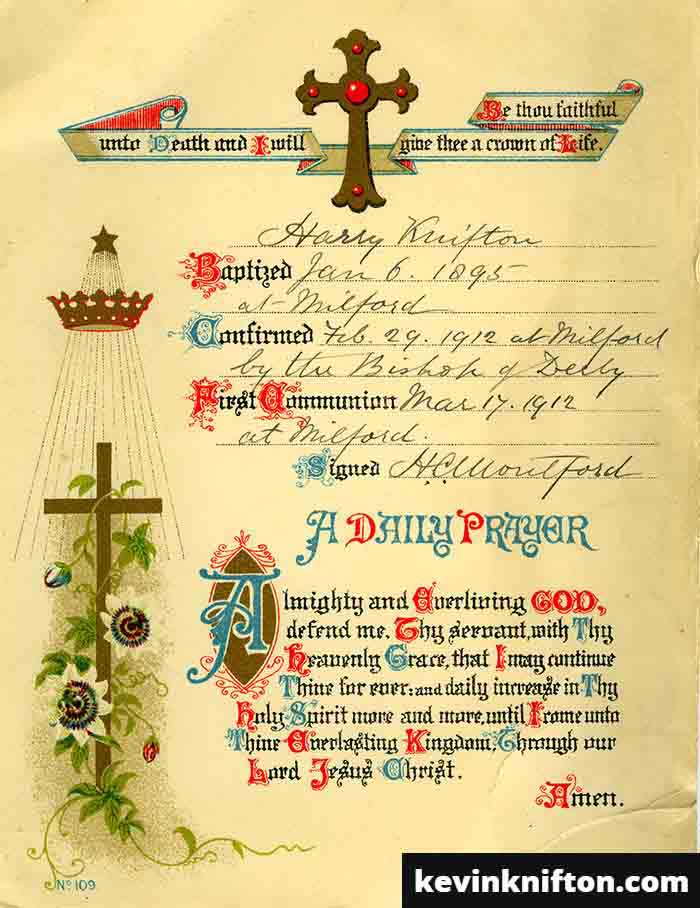
As a teenager, Harry worked at both Red Hill Farm and Grange Farm, which his mother rented from the Strutt Estate. All the work in the fields was done using horses. Harry had a great fondness for his horses, one of which is known to have been called Bob.
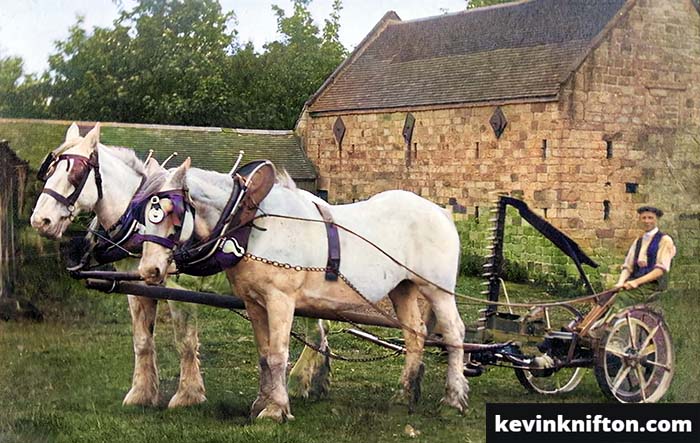 Harry Knifton, circa 1912
Harry Knifton, circa 1912
While aged between 16 and 18, Harry caught his right hand in a chaff cutter (a mechanical device used for cutting straw or hay into small pieces for cow feed). Two of his fingers were injured, and the following day the shock from this accident caused his hair to start to fall out.
To complement the horses, Red Hill Farm also had a Fordson tractor. Harry is known to have had a .410 bore shotgun, a 12 bore shotgun, and two riffles. The shotguns remained in the family until circa 1988 when new UK law required all shotguns to be securely stored and registered. The family decided to sell the shotguns to a local dealer. The two rifles had been sold several years before.
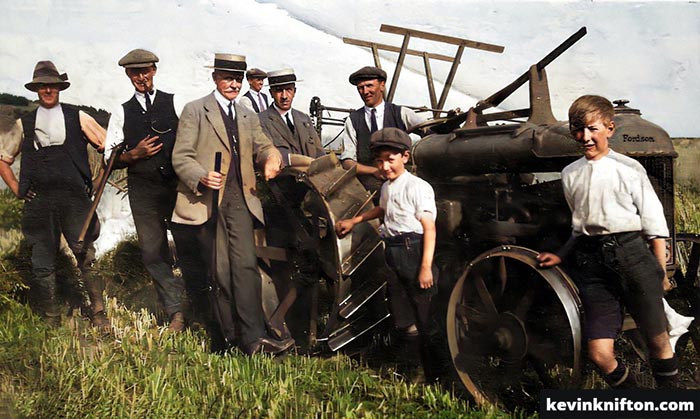 Harry Knifton, seated on Fordson tractor,
Harry Knifton, seated on Fordson tractor,with Frank sat on the binder. One of Harry’s shotguns is also pictured.
Harry’s sister Eva married Wilf Alton in 1915, and his sister Florrie married John Bridges in 1921. Also in 1921, his brother Frank married Esther Marion Smith and he took over from his mother as the tenant of Grange Farm, which would become his family home. This left Harry and his younger brothers Jack and Russell to run Red Hill Farm. Harry also used to work for his brother-in-law John Bridges who, as well as being a farmer at Moscow Farm, was also a threshing contractor. Harry is known to have done threshing in the Carsington area when working for John Bridges.
Harry’s mother died on 25th March 1930. In her Will she wrote that ‘if on my death my said son Harry shall desire to succeed me on the Red Hill Farm he shall have the option of purchasing my live and dead farming stock implements of husbandry thereon and the tenant right in respect thereof and also my household furniture and effects at such price as shall be put on the same to be made by a valuer in the usual way’. Harry was to be allowed two months to consider this, but decided not to purchase the farm’s assets. The same option was then to be given to Harry’s brother Frank, but he also did not take up the offer.
Harry’s brothers Jack and Russell both married in 1931. Russell and his wife continued to live at Red Hill Farm with Harry. Harry ran the farm, which included a dairy, with Russell helping with the milk round.
Harry may have met his future wife Winnie while working in the fields on Duffield Bank near a house where she was in service. While courting Winnie, Harry had two dogs, a red or golden retriever called Racy, and a terrier. Harry and Winnie used to walk in the fields when courting.
 Winnie’s engagement ring
Winnie’s engagement ring
Harry Knifton married Winifred Williams on 28th July 1934 at St Ann’s Church, Ambergate. Harry’s best man was his brother Jack, and Winnie’s bridesmaid was her sister Doris. Winnie was given away by her father, who together with her mother, Jack Knifton, and A. Alton, were witnesses to their marriage.
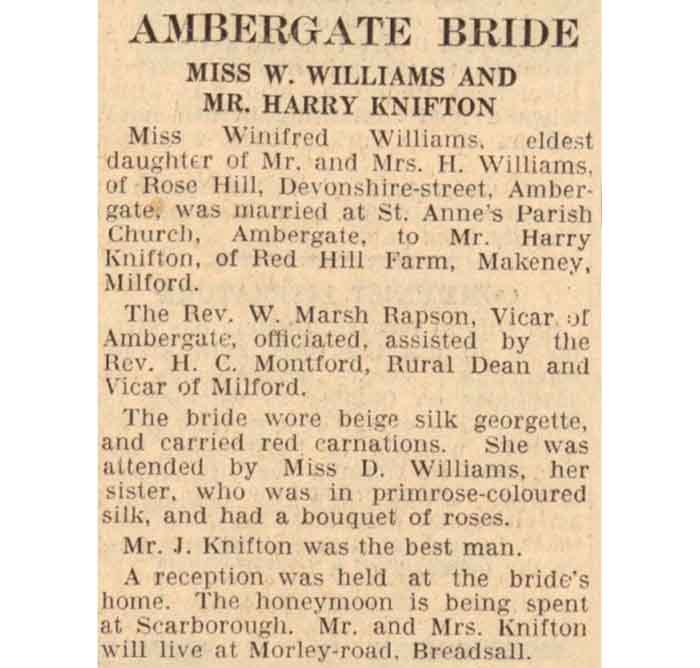
On her wedding day, after a rain shower, Winnie’s grandmother Ellen Blackham said to Winnie ‘this is how your marriage will be - sunshine and showers’.
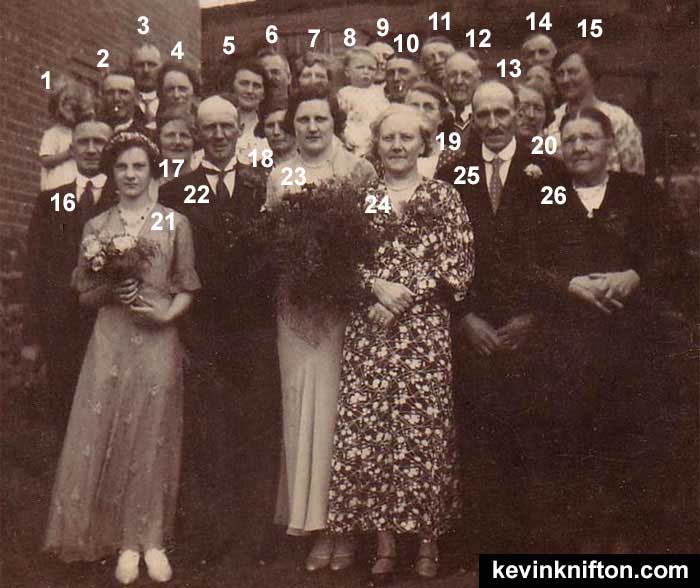 Harry and Winnie’s wedding party, Rosehill
Harry and Winnie’s wedding party, Rosehill1 Dorothy Knifton, 2 Frank Knifton, 3 Wilfred Joseph Alton, 4 Esther Marion Knifton, 5 Florrie Knifton, 6 Mr. Clarke, 7 Ethel Knifton, 8 Margaret Helen Knifton, 9 George Williams, 10 James Russell Knifton, 11 Frank Blackham, 12 John William Briggs, 13 Amy Clarke, 14 Frank Clarke, 15 Annie Whittingham, 16 John Knifton, 17 Eva Marion Knifton, 18 Mary Ann Briggs, 19 Emma Blackham, 20 Mrs. Clarke, 21 Doris Williams, 22 Harry Knifton, 23 Winifred Knifton (née Williams), 24 Hannah Rebecca Williams, 25 Ellen Blackham
Winifred Williams
Winifred Williams, known as Winnie, was born on 15th March 1908 in Ambergate, the oldest child of Henry and Hannah Rebecca Williams.
By 1913 the family had moved to 8 Oxford Street in Spondon, Derby, and Winnie, aged 5, attended Reginald Street Infants School from 27th October to 28th November 1913. The school was in the Rose Hill area of Derby, near to the railway station, which is perhaps where her father worked. Towards the end of 1913 the family moved to 82 Francis Street in Chaddesden, Derby. On 8th December Winnie was admitted to the nearby Nottingham Road Infants School on St Mark’s Road, where she stayed until 17th September 1914, when the family moved to Worcestershire. Her father was granted a licence for the Plough Inn at Baughton, Earl’s Croome, and Winnie attended Earl’s and Hill Croome School from 28th September 1914 to 13th December 1915.
Winnie’s brother George was born in Baughton in May 1915, and when Winnie was seven years old, the family moved again, this time to ‘Rosehill’, a private residential hotel in Cheltenham, where the family lived in rooms within the stable building. Here her father worked as a stockman, shortly before he enlisted with the Durham Light Infantry.
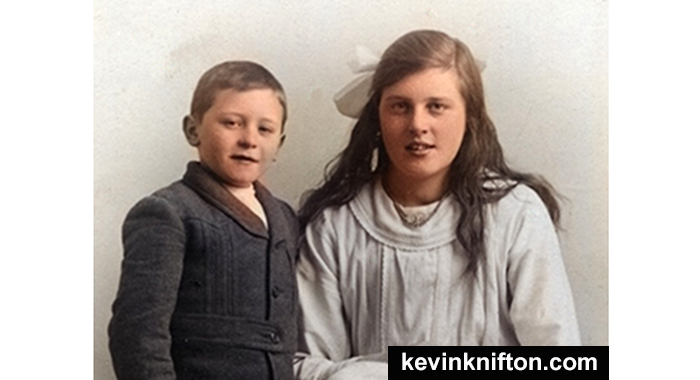 George and Winifred Williams, circa 1920
George and Winifred Williams, circa 1920
After being discharged from the army, her father resumed his work as a stockman at Rosehill. Her mother worked at the Cheltenham racecourse, where Winnie’s sister Doris was born in 1923.
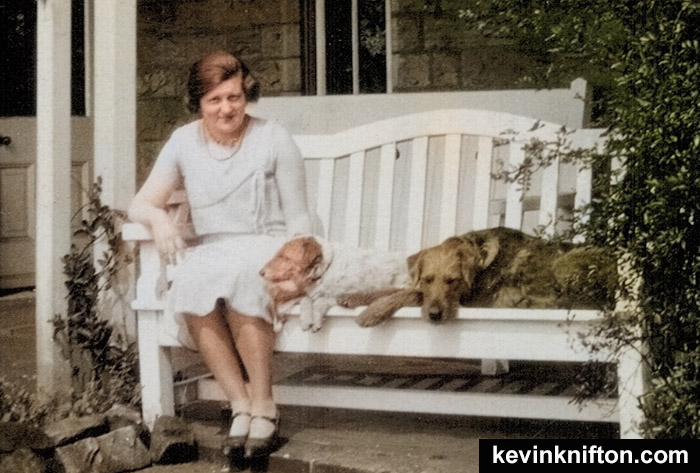 Winnie with Jem and Tatters, Cheltenham, circa 1928
Winnie with Jem and Tatters, Cheltenham, circa 1928
Between 1923 and 1930, Winnie moved back to Ambergate with her parents, initially living on Toadmoor Lane. On 15th March 1929, the occasion of her 21st birthday, Winnie was given a pair of cut-glass vases, which still survive.
In 1931 the family moved to a house they named ‘Rosehill’, at the top of Devonshire Street (now 1 Birch Avenue), Ambergate, where in later life Winnie’s grandmother Ellen would join them.
Before meeting Harry, Winnie worked in service. For a short time she worked for Mrs Wood of Edward Wood and Sons, but soon ran away since they accused her of stealing a bed spread. Afterwards she worked at Jobson’s near Duffield Bank, where she may have met Harry. Winnie told the story of how she used to help herself to sweets left at the bedside of Mr Jobson. One day she opened the tin and found a note which read ‘You’ve had your share, now leave the rest for me’.
Winnie was given a Brownie camera for her 21st Birthday and took many photographs in her younger years. She gave me the camera in 1988, and both her photograph album and camera survive.
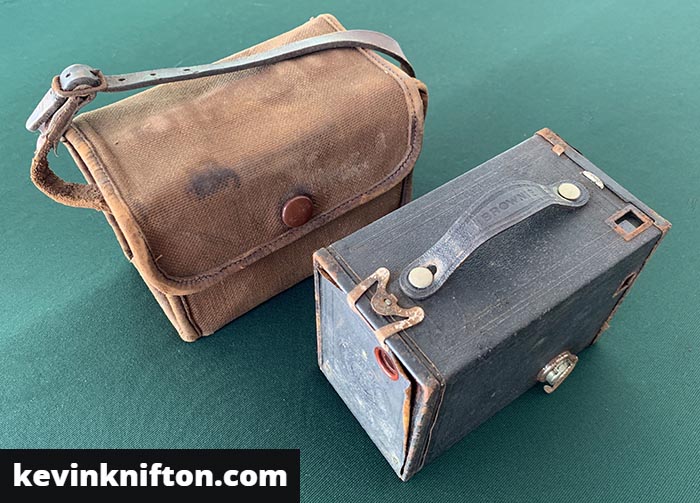 Winnie’s Brownie camera
Winnie’s Brownie camera
Family life
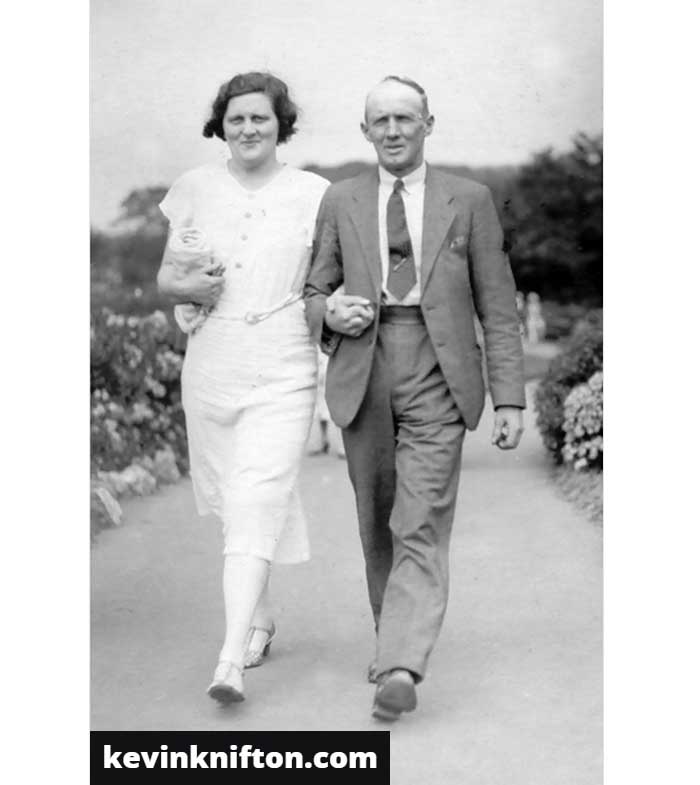 Winnie and Harry Knifton, circa 1934
Winnie and Harry Knifton, circa 1934
Soon after returning from their honeymoon at Scarborough, Harry and Winnie lived at 3 New Row Cottages, off Moor Road, in Breadsall. Now demolished, it was one of five cottages in a row.
In November 1934, the contents of Red Hill Farm were put up for auction and the tenancy ended.
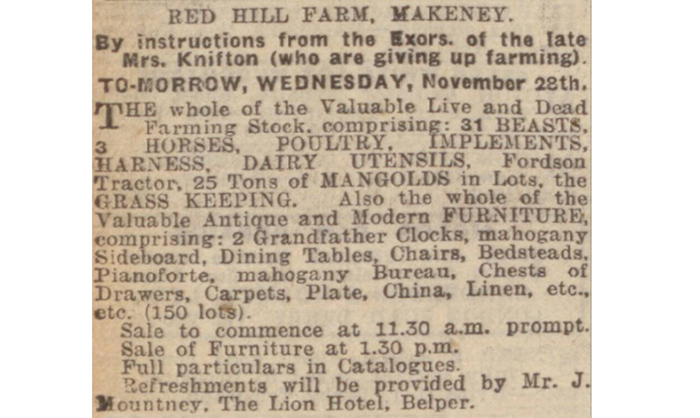
Between 1934 and 1936 Harry started his own agricultural contracting business. He began with a Robey traction engine and a Robey threshing drum (probably with the trusser) which he bought for £5 from Tom Hart in Stanley. Mr Hart had bought the machines new in 1908 - they were known in Harry’s family to be as old as Winnie. Tom Hart used to do the threshing at Red Hill Farm before the drum was sold to Harry. He also bought other equipment, including a chaffer and Ransomes bailer. While living at Breadsall, Harry kept his traction engine and threshing drum in the yard of Mr Bates, the local blacksmith. Harry didn’t have a car but would cycle between his home in Breadsall and wherever he was threshing if he needed to fetch oil for the drum.
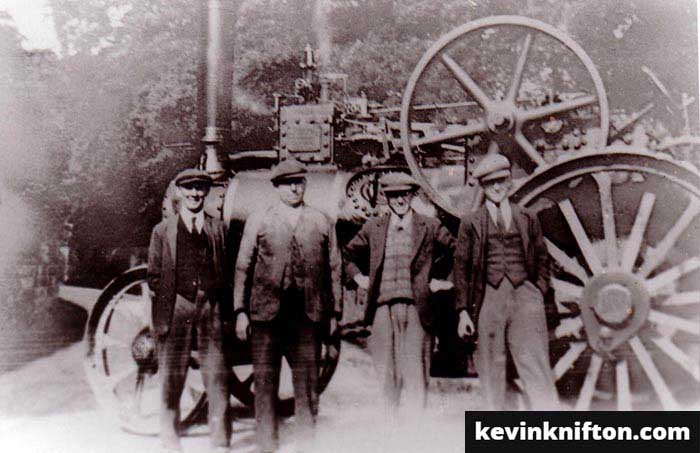 Harry (left) with his Robey traction engine
Harry (left) with his Robey traction engineBrian Kilburn (second left) used to work for Harry
From September through to March, Harry would be threshing, while during the summer months he would be busy bailing, so Winnie would take her sister Doris and niece Eva Marion Knifton on holiday to Scarborough. For his threshing work, Harry used to bill the farmers in March, the end of the threshing season; many would still ask for a discount even after six months!
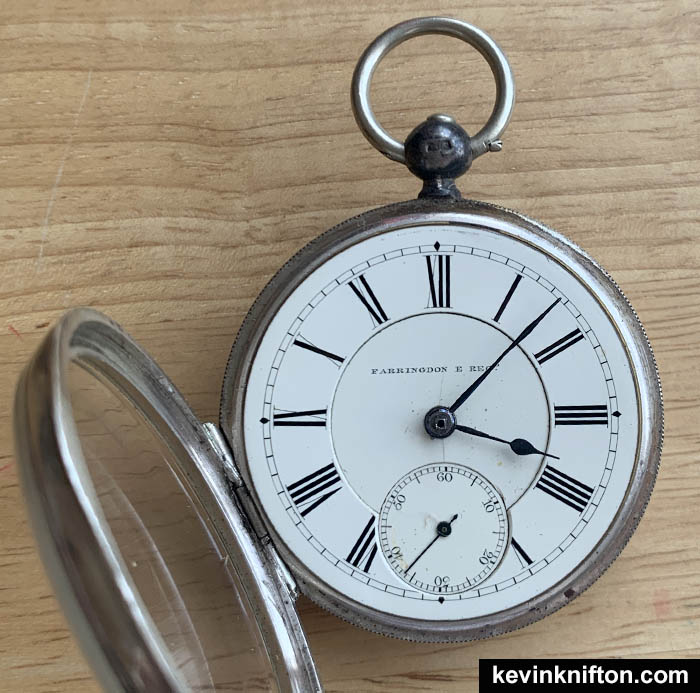 Harry’s pocket watch, which he wore every day
Harry’s pocket watch, which he wore every day
Harry and Winnie’s first child, James ‘Ian’ Knifton, was born at Rosehill, Winnie’s parents’ house in Ambergate, on 18th June 1935. His baptism certificate notes that he was baptised on 16th July by the Vicar of Ambergate. However, he appears to have been ill since the baptism was done privately, perhaps at Rosehill. A few days later, Ian was taken to Derby Royal Infirmary where he died. He was buried in a small coffin behind the headstone of his grandparents’ grave in Horsley Churchyard on 20th July 1935.
Harry and Winnie’s second child was born in 1936, and the family were still living at Breadsall in September 1939. However, by the end of the year, the family had moved to Horsley Woodhouse, renting a house called Woodwynde at 43 Wood Lane for 12s. 6d. a week.
During the Second World War, the local ‘War Ag’ office instructed farmers how much corn they had to grow. The office had five sets of tractors and threshing drums but also needed contractors such as Harry. We know Harry was threshing at Stanley between 29th May and 29th July 1941.
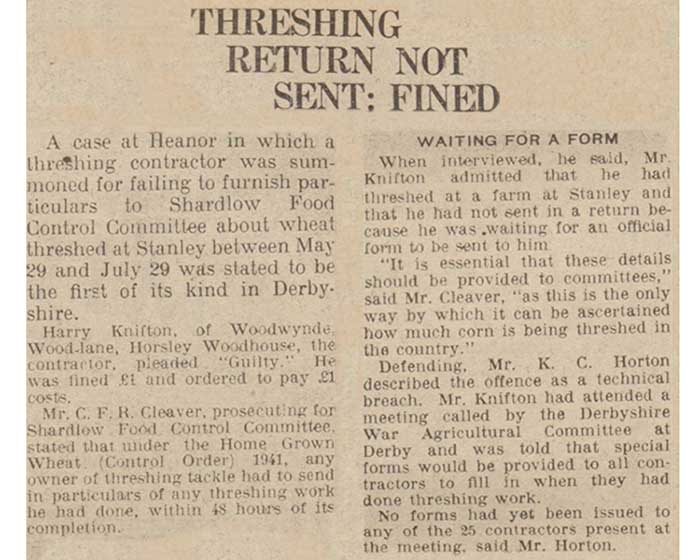
After the war, Harry continued with his contracting business, taking his threshing drum to farms in Horsley Woodhouse, Smalley, Morley, Horsley, Denby, Spondon, Breadsall, Kilburn, and Stanley.
Harry and Winnie’s third child was born in 1943 at 43 Wood Lane, followed by their fourth child, Richard, in 1945.
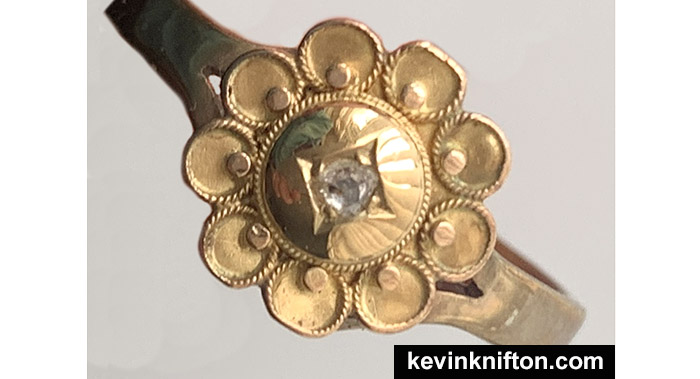 Harry’s tie pin which was later made into a ring
Harry’s tie pin which was later made into a ring
Harry used his Robey steam engine until 1947, when he bought a McCormick International W9 tractor from Arthur Hibbert of Eggington. First registered in 1945, the W9 was red and carried the registration plate JRA20. Arthur Hibbert was also an agricultural contractor but became ill. During his illness the men working for him were reported to be seen driving the tractor too fast so he decided to sell it and buy slower equipment: Arthur subsequently recovered. Harry’s W9 replaced the Robey traction engine, which was left with a cover over it. Although the engine was in working condition, it had no use, and Harry decided to sell it to Wards of Sheffield for £25 in June 1951. The engine stood in Wards yard at Ilkeston for two years before being dismantled.
All the required service and maintenance work for his equipment was done by Harry himself; oil in his tractors was changed weekly; he was said to always have an oil can in his hand!
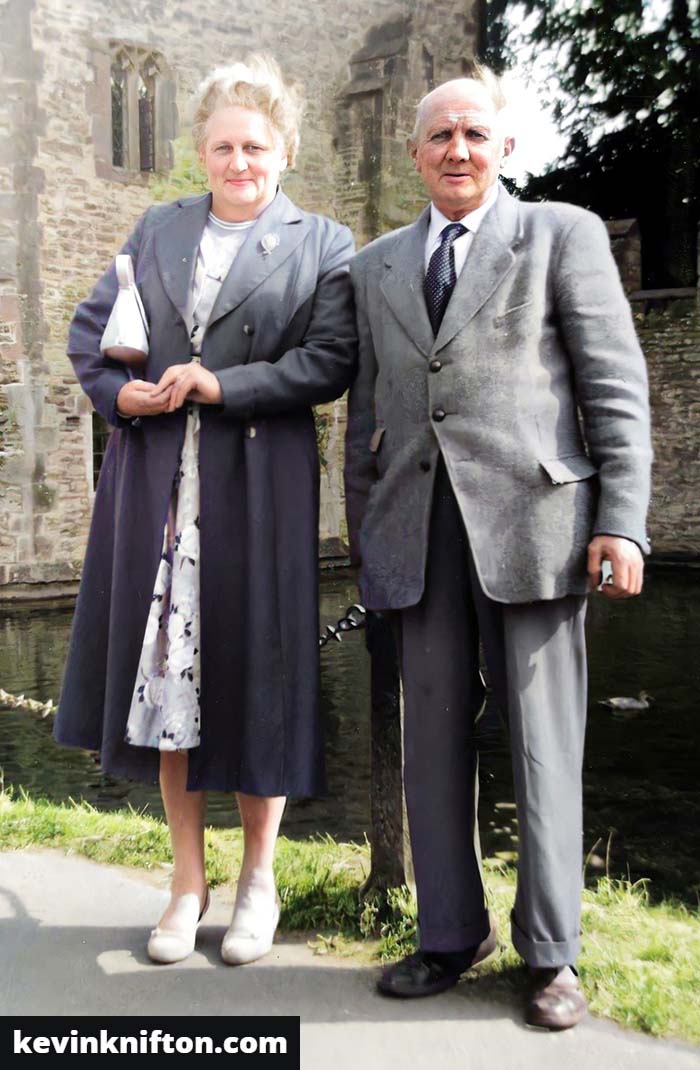 Harry and Winifred Knifton, circa 1947
Harry and Winifred Knifton, circa 1947
At Wood Lane, Harry had a shed built for his W9 tractor, while in the garden sat his machinery and a TVO tank. The garden had a coalhouse and a small sty where Harry kept pigs. Generally he only kept one at a time but on one occasion he bought seven from a farmer near Allestree, but they had a disease and all died, so he then only kept one or two.
The family kept chickens and bantams at Wood Lane, where the birds had free-range amongst the apple trees. Both the eggs and hens would be sold. Harry would also raise 20 to 30 cockerels which would be sold for Christmas after Winnie had plucked and dressed them. Straw and corn for the birds came from the threshing machine. The children also grew up with an Alsation-Huskey cross bitch called Racy whose kennel was made from a beer barrel.
On entering the house, the stairs were directly ahead. The living room was to the right, and the kitchen and pantry at the back. The sitting room was on the left. Up the stairs, their daughter had a small bedroom overlooking the back. There was a bathroom (the toilet was outside), and another bedroom at the back, shared by their two sons. Winnie and Harry’s bedroom was at the front of the house. The 1870 Blackham family Bible which once belonged to Winnie’s great-grandfather sat on a chest of drawers at the top of the stairs.
Harry was also a keen gardener, growing kidney beans, carrots, peas, beetroot, potatoes and onions. The family never had to buy vegetables.
Many times Harry and Winnie offered to buy Woodwynde from its owner George Brooks, but it wasn’t until after his death in 1955 that his daughters sold it to them.
In January 1959, Harry and his oldest son were in the W9 tractor, descending towards the bend near the Hunters Arms at Kilburn. As they turned the corner, a lorry coming from the right skidded sideways and hit the tractor’s engine, breaking it into three parts. It was unusable. Harry bought another used W9 tractor (registration plate EFU 50) from Cripps of Triumph Road, Nottingham, and a pick-up bailer at the same time.
Harry bought a used Massey Harris 726 combine harvester from Burgess of Derby (registration plate GUJ 202). In 1960 he added a David Brown 25D tractor (registration plate 215 ANU), which was smaller than the W9 but with high and low gears suitable for bailing. He also bought a plough for the David Brown. The combine was kept in a barn that Harry had built, and the David Brown, pick-up bailer, and plough were kept in a lean-to shed, which is where he also hung onions that he had grown in the summer.
Harry Knifton died at Woodwynde on 21st October 1965, aged 70. He had suffered from breathing difficulties caused by threshing dust.

His funeral was held on 25th October at St Susannah’s Church, Horsley Woodhouse, followed by burial in the churchyard at St Clement’s Church at Horsley. St Susannah’s was the family church for Harry, Winnie, and their children, but Harry always said that he wanted to be buried at Horsley, which is where his parents were buried.
Harry was buried in an English oak coffin. A white marble curb memorial was erected in July 1966 with a white marble vase and white marble chippings on the top, although when they became dirty Winnie had them replaced with green stones. The far side of the inscription read ‘IN LOVING MEMORY OF A DEVOTED HUSBAND AND FATHER’ and on the east side ‘HARRY KNIFTON AT REST 21ST OCT. 1965 AGED 70 YEARS’. The west side was left blank, the intended place for the future inscription for Winnie. However, for practical maintenance purposes, the curbing needed to be replaced, which Winnie asked to be done after her death. It was replaced with a headstone.
The Robey threshing drum which Harry had used for most of his working life was given to John Bosworth, a butcher at Smalley, by Winnie. The drum then found its way to Elvaston Castle, where it was neglected and fell into ruin. In 2000 it was acquired by a local farmer for restoration. The drum had found its way back to where it originated.
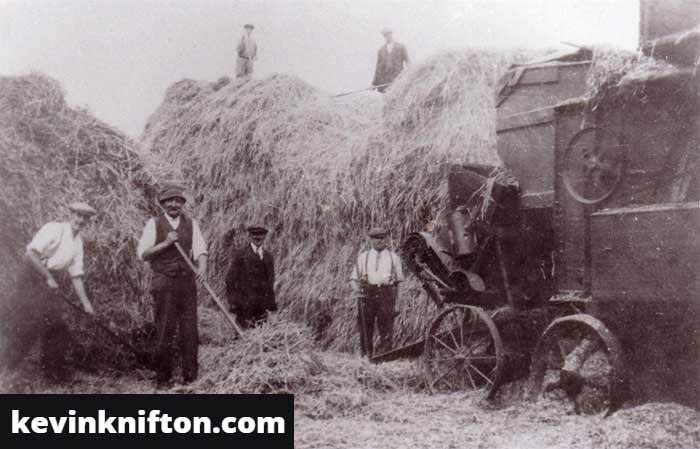 Harry (centre) with his Robey threshing drum and Massey Harris trusser.
Harry (centre) with his Robey threshing drum and Massey Harris trusser.Brian Kilburn is between Harry and the trusser.

Winifred’s later life
After her husband’s death, Winnie continued to live at Woodwynde for two years. On 15th September 1967 she paid a deposit for a house at 69 Wellington Street, Heanor, which she moved in to with her youngest son Richard, on 31st January 1968. One of her other children was also living in the area.
Winnie was very much involved with the Heanor Mencap Society, being their secretary for many years, before handing the role over to her daughter. Funds were raised for a new mini-bus which was used to collect the children from home and take them to the youth club, swimming baths, and to other activities.
She was very supportive of her son Richard, who was a strong swimmer, and attended all his swimming competitions.
Winnie clearly liked dogs. I recall that she always gave treats to our dog ‘Flash’. We lived about four miles away, and Flash would often disappear into the fields at the back of our house. The phone would ring and Winnie would ask ‘Have you lost anything?’ Flash used to make his way to her house, crossing a main road and finding his way across several fields and streets, perhaps the route that we used when we walked to visit her. Flash would always turn up at Winnie’s house.
Even in her eighties, Winnie would often walk to Heanor, a short journey, but one which required going up the steep main High Street. I remember her telling me one day how she had called into a record shop trying to find an album for Richard. She said the person in the shop was very kind and friendly, but didn’t have what she was looking for. When she explained to me where the shop was, I realised this was the local heavy-metal shop, which as a teenager I wouldn’t have been brave enough to enter!
Winnie died on 13th December 1991 at the Derby Royal Infirmary. She was 83 years old. Two days earlier we had visited her at the hospital. It was a poignant moment as we were leaving when she said ‘Goodbye Kevin’.
Her funeral service was held at St Susanna’s Church, Horsley Woodhouse, at 2 p.m. on 19th December, during which Jesus, lover of my soul was sung, followed by interment in the churchyard at Horsley. I remember as we stood around the grave with the coffin being lowered how the driving rain and battering wind combined to make this a dramatic and saddening event.
The memorial to Harry, Winnie, and their son Richard stands in Horsley Churchyard.
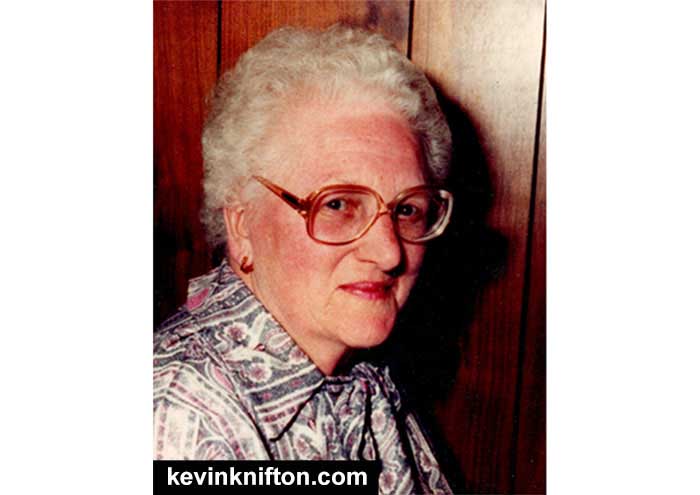 Winifred Knifton, circa 1988
Winifred Knifton, circa 1988
I remember my ‘Gran’ as ever cheerful, who interested me with stories of her past, and who lived a life to be proud of.
Harry and Winnie Knifton were my grandparents.